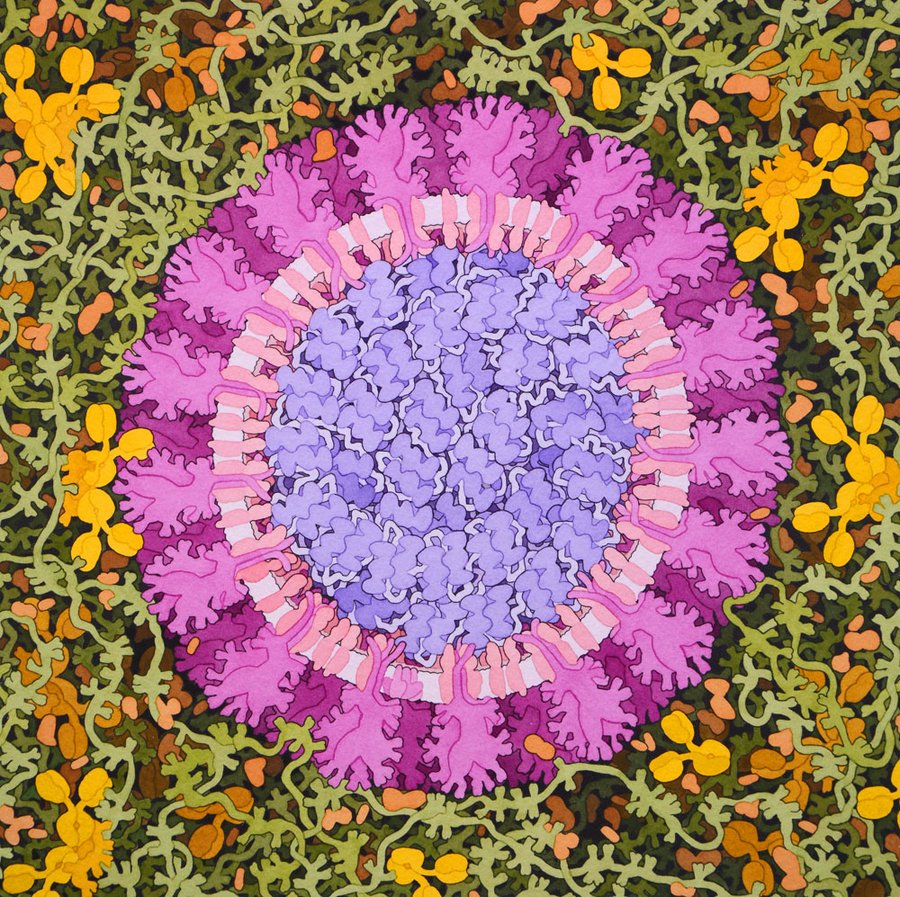Every time a genome is replicated, there’s a chance that an error will be introduced. This is true for all life forms. On a small scale, these mutations can lead to genetic diseases or cancers. On a much larger scale, random mutations are an important tool of evolution.
During the COVID-19 pandemic, the SARS-CoV-2 virus has picked up many mutations as it spread around the world. Most of these mutations have been inconsequential – the virus didn’t change in any significant way. Others have given rise to variants such as B.1.1.7 and B.1.351, which present complications for public health efforts. By studying the evolution of the virus, we can monitor how it’s spreading and predict the characteristics of variants as they are detected.
Viral Variants
Viruses can evolve much faster than multicellular life forms. A single infected individual represents trillions of virus particles – the virus might be replicated as many as 100 trillion times. At this rate of replication, new mutations are more than just likely; they’re happening constantly. When a virus gains a mutation, it becomes a variant. A variant is a form of the virus that is genetically distinct from its ancestral form.
Most variants aren’t unique in their behavior. A single nucleotide substitution might not even change the amino acid sequence. However, monitoring these variants through viral sequencing gives us valuable insights into how the virus is moving and changing through space and time.
The sequence of a viral genome forms a sort of fingerprint for that specific sample, and it’s linked to a specific place and time. When enough of those fingerprints are collected, they can form a map of how the virus is spreading. For example, if you know when and where a specific mutation was first documented, and later you see that mutation popping up in in neighboring cities, you know that people from each city must be spreading the virus to each other. Public health organizations can use this information to decide whether current prevention measures are effective.
Tracing Viral Evolution
In addition to informing and evaluating public health decisions, sequencing data helps researchers construct the phylogeny of the virus. Starting with the first known ancestral form of the virus, new variants can be arranged based on their evolutionary relationships. These diagrams quickly become massive, as new variants are constantly being discovered.
Researchers group these variants into clades based on their shared evolutionary history. A clade is any monophyletic group with a shared evolutionary history. By grouping variants into clades, researchers can easily describe how different lineages are spreading through geographic regions. It also helps track lineages that are known to have biologically significant mutations that could have human health consequences.
For more information on how viral sequencing informs public health decisions, check out our recent blog, “From Primate Models to SARS-CoV-2 Sequencing and Testing.”
Variants of Concern
Not every variant is harmless. Several variants of SARS-CoV-2 have emerged with unique or enhanced properties that call for special attention. As mutations naturally occur, some of them will result in modifications to key proteins. Depending on which proteins they affect, such mutations could lead to increased transmissibility, more severe disease, or many other consequences. For example, the SARS-CoV-2 mutation D614G, in which an aspartate in the spike protein is changed to a glycine, has been associated with increased transmissibility. D614G emerged in Europe early in the pandemic and is present in most COVID-19 cases Europe and the Americas.
A “Variant of Interest,” refers to any variant with a genetic marker that has been associated with a phenotypic change. For example, the variant B.1.526 has mutations that give it the potential to avoid detection by the immune system following vaccination or previous infection. This attribute is predicted, but hasn’t specifically been proven at this time.
Once there is evidence that a variant has concerning attributes, it becomes a “Variant of Concern.” Variants in this category might require new guidelines or restrictions, based on their spread. B.1.1.7, the variant first discovered in the UK, is approximately 50% more transmissible than previous forms of SARS-CoV-2. This led the UK to intensify lockdowns until infections rates were reduced.
If a variant is able to escape or reduce the effectiveness to current prevention measures and medical countermeasures, it is classified as a “Variant of High Concern.” These variants might evade detection by current diagnostic methods, escape vaccine immunity, or resist any therapeutics commonly used to treat the disease. At this time there are no SARS-CoV-2 Variants of High Consequence.
Studying the evolution of viruses or variants of SARS-CoV-2? Explore our tools for viral research.
Related Posts
Latest posts by Jordan Villanueva (see all)
- Tackling Undrugged Proteins with the Promega Academic Access Program - March 4, 2025
- Academic Access to Cutting-Edge Tools Fuels Macular Degeneration Discovery - December 3, 2024
- Novel Promega Enzyme Tackles Biggest Challenge in DNA Forensics - November 7, 2024

